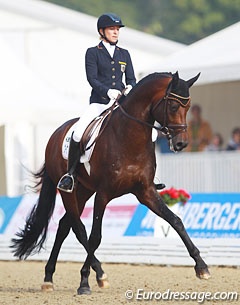
Our dressage partners, just like us, have strong point, and weak points, stronger sides and weaker sides, and this is not just because of their genetics, but because of the natural anatomy of our friend the horse!
“The majority of horses have a concave side and a convex side.” said Nuno Oliveira! Often referred to as the hollow and the stiff side of the horse, riders will find it easier to bend their horse to one way than to the other, and this is something the rider must learn to accommodate this natural curve in their training method, to ensure they present a balanced horse in competition.
“It is quite often that as a judge we can detect the weaker side of the horse,” says Mexican O-Judge Maribel Alonso. “For example, the turn on the hollow side of the horse is bigger than the one on stiff side. We may also see overbending laterally to the side that the horse is hollowed, or counterbending on the stiff side.”
Maribel advises that there are many elements to the test where the asymmetry of the horse is evident, and where, if the rider is not aware or does not learn to ride the horse accurately on both sides, marks will be lost.
“You will see riders cutting the corners on the stiff side, showing half passes that will appear easier on the hollowed side, while on the stiff side the hindlegs will tend to drift out," she said. "The shoulder-in to the stiff side will have a more correct angle, but maybe not produce the correct bend.”
So how do we as riders overcome the natural asymmetry of the horse and produce a test that is matched both in balance and direction? Nuno Oliviera used to advise that riders must work the same on both sides, with the same language to ask for the exercises, but vary the degree of that language in order to produce an even ability on both sides.
“To perform an exercise like a shoulder-in, for example, the language of the aids will be the same on both sides, but the dose of the aids will be different,” Olivera phrased it.
The biggest thing to remember according to the great master is that on the convex side, for instance on the right side, if the horse is naturally bent left, play with the right rein to lighten the contact, but don’t pull while trying to keep the contact on the other side, the left side. “The horse usually has a tendency to not take the contact on the concave side,” added Nuno!
 Often we see riders who, when riding on the rein that is naturally stiffer (the convex side), pull on the inside rein to haul the horse around and create inside bend. This is of course ineffective, and it forces a greater degree of tension on the horses naturally stiffer side.
Often we see riders who, when riding on the rein that is naturally stiffer (the convex side), pull on the inside rein to haul the horse around and create inside bend. This is of course ineffective, and it forces a greater degree of tension on the horses naturally stiffer side.
“A horse has less neck muscles on the concave side. If the rider pulls on the rein on the convex side, he will develop yet more muscles on that side by pulling and resisting. An endless fight will ensue," Nuno stated.
It is thus important for riders to work the both sides of the horse with tact and feel, so they can adjust themselves and the degree of their aids in order to work for symmetry in the movements they put on show.
“As there is a natural crookedness in every horse the rider must work to produce eveness, and to make the horse functional” said Maribel. “This is a never ending process to work, grow, adjust, and improve with this crookedness, and the top riders do that!”
So how do we work to improve and aid the horse on both sides evenly? Well known trainer Jan Bemelmans advises that correct use and execution of the half pass can improve the straightness of the horse and it is in these gymnastic exercises that the horse develops the strength to find balance and develop the muscles evenly. Bemelmans recommends travers and renvers as helpful exercises.
And, why should riders work with and not against the natural curve of the horse? This is not only important to show evenness as, according to Maribel, only a balanced horse will be able to show self carriage, impulsion and collection.
“In my opinion, the top rider does lessen the stronger side of the horse, or the side that he may find easier, in order to produce a balanced test, and many also compensate with their aids, which they may vary at times depending on the exercise. A good rider will adjust his/her aids to produce eveness until it is achieved. Until the feeling of two different horses in one is gone.”
Another thing to keep in mind is that when the crookedness of the horse is not accounted for in training, this can alter the natural rhythm of the horse, making him more prone to uneveness and lameness.
“Good and balanced training keeps horses sounder, happier, and healthier,” Maribel added. “The worst thing is to overlook the natural curve of the horse and let it affect the horse's balance and later on his soundness.”
And, just like horses, Maribel reminds us not to forget that we as riders also have a stronger and more dominant side, and we must also be aware of our body and our strength in order to use both to our, and our horse's own benefit.
by Sarah Warne for Eurodressage
Related Link
Sarah Warne's Classical Training Articles